Gigabyte Z77-HD4 Review
by Ian Cutress on May 19, 2013 10:00 AM EST- Posted in
- Motherboards
- Gigabyte
- Z77
Readers of our motherboard review section will have noted the trend in modern motherboards to implement a form of MultiCore Enhancement / Acceleration / Turbo (read our report here) on their motherboards. This does several things – better benchmark results at stock settings (not entirely needed if overclocking is an end-user goal), at the expense of heat and temperature, but also gives in essence an automatic overclock which may be against what the user wants. Our testing methodology is ‘out-of-the-box’, with the latest public BIOS installed and XMP enabled, and thus subject to the whims of this feature. It is ultimately up to the motherboard manufacturer to take this risk – and manufacturers taking risks in the setup is something they do on every product (think C-state settings, USB priority, DPC Latency / monitoring priority, memory subtimings at JEDEC). Processor speed change is part of that risk which is clearly visible, and ultimately if no overclocking is planned, some motherboards will affect how fast that shiny new processor goes and can be an important factor in the purchase.
For reference, the Gigabyte Z77-HD4 does enable MCT when XMP is enabled.
3D Movement Algorithm Test
The algorithms in 3DPM employ both uniform random number generation or normal distribution random number generation, and vary in various amounts of trigonometric operations, conditional statements, generation and rejection, fused operations, etc. The benchmark runs through six algorithms for a specified number of particles and steps, and calculates the speed of each algorithm, then sums them all for a final score. This is an example of a real world situation that a computational scientist may find themselves in, rather than a pure synthetic benchmark. The benchmark is also parallel between particles simulated, and we test the single thread performance as well as the multi-threaded performance.
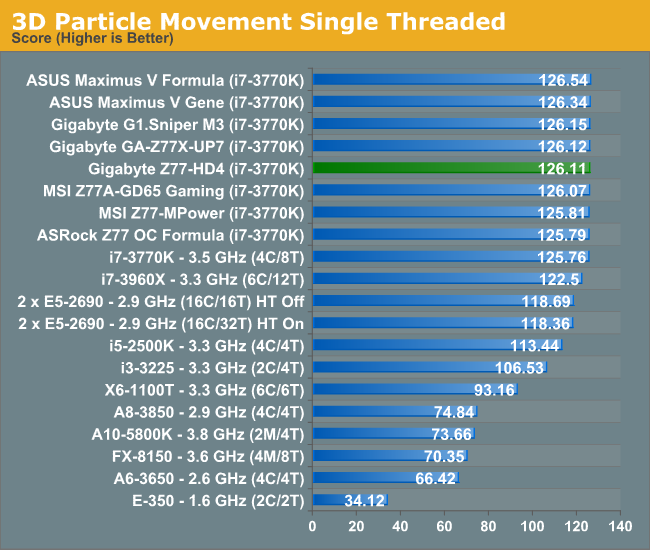
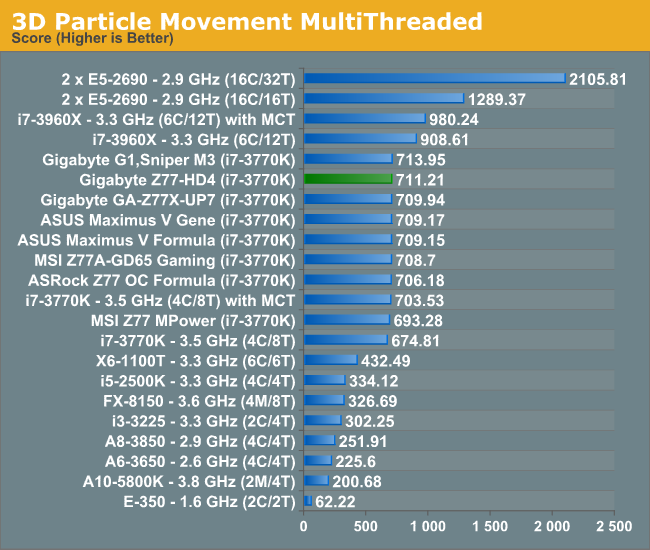
For a $120 motherboard, despite the DPC and Boot Time inefficiencies, the Z77-HD4 deals really well with our 3DPM benchmark, showcasing nice efficiency in multithreaded load. We do not test the memory here, so it provides a contrast result to the poor WinRAR performance below.
WinRAR x64 3.93 - link
With 64-bit WinRAR, we compress the set of files used in the USB speed tests. WinRAR x64 3.93 attempts to use multithreading when possible, and provides as a good test for when a system has variable threaded load. If a system has multiple speeds to invoke at different loading, the switching between those speeds will determine how well the system will do.
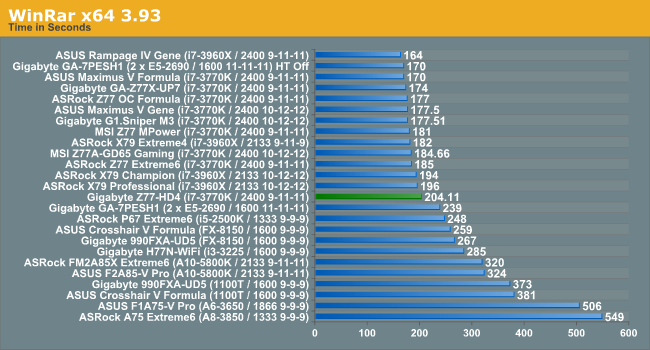
Despite the good 3DPM showing, the WinRAR score comes in as the worst 3770K+ at 2400 C9/C10 we have had. In contrast, for our new WinRAR 4.2 testing, the Z77-HD4 scored 54.36 seconds.
FastStone Image Viewer 4.2 - link
FastStone Image Viewer is a free piece of software I have been using for quite a few years now. It allows quick viewing of flat images, as well as resizing, changing color depth, adding simple text or simple filters. It also has a bulk image conversion tool, which we use here. The software currently operates only in single-thread mode, which should change in later versions of the software. For this test, we convert a series of 170 files, of various resolutions, dimensions and types (of a total size of 163MB), all to the .gif format of 640x480 dimensions.
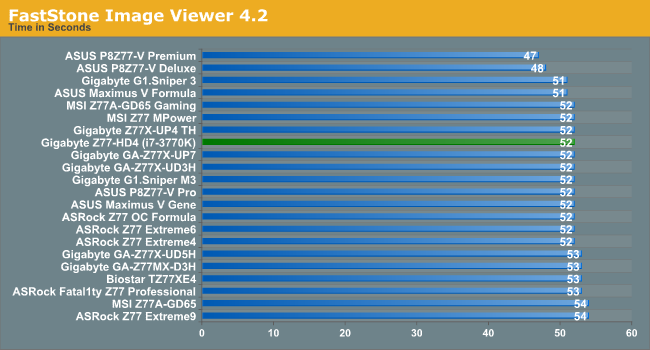
Xilisoft Video Converter
With XVC, users can convert any type of normal video to any compatible format for smartphones, tablets and other devices. By default, it uses all available threads on the system, and in the presence of appropriate graphics cards, can utilize CUDA for NVIDIA GPUs as well as AMD APP for AMD GPUs. For this test, we use a set of 32 HD videos, each lasting 30 seconds, and convert them from 1080p to an iPod H.264 video format using just the CPU. The time taken to convert these videos gives us our result.
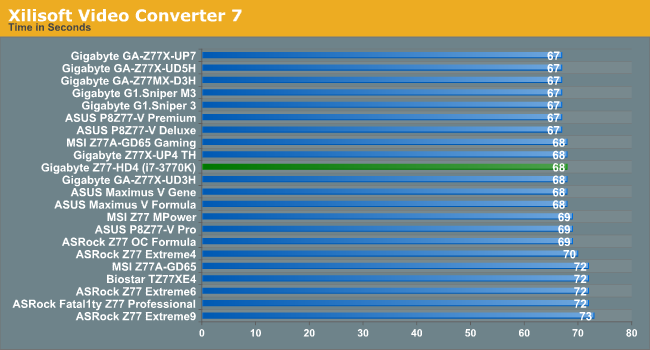
x264 HD Benchmark
The x264 HD Benchmark uses a common HD encoding tool to process an HD MPEG2 source at 1280x720 at 3963 Kbps. This test represents a standardized result which can be compared across other reviews, and is dependent on both CPU power and memory speed. The benchmark performs a 2-pass encode, and the results shown are the average of each pass performed four times.
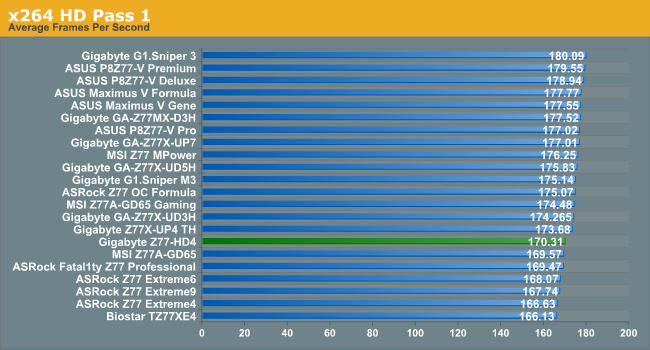
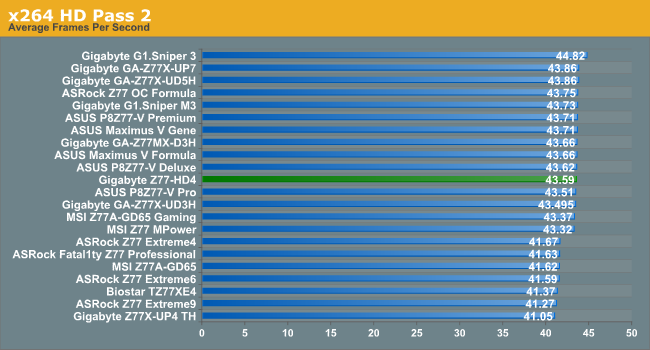










63 Comments
View All Comments
Cerb - Tuesday, May 21, 2013 - link
I also don't need heatsinks, or LEDs, or buttons, or anything glow in the dark (now, tritium, on the other hand...).But, a video card? I've spent more on motherboards so as not to buy a video card ever since good IGPs started coming out around 2004-2005, and chose AMD platforms when Intel's were faster, for the superior IGP. Most of the time, I'm buying a video card today, due to either Intel's drivers not being up to the task, or due the motherboard lacking output options. The more of those the board has, the better, doubly so if they can all be used simultaneously (which, oddly, seems to be common on notebooks, but not desktops). I have a video card, but most people don't, and that's including more overclockers, too, every time IGP improves. Multimonitor is getting more common all the time, and most users do not need more performance than the IGP offers.
Most people do not have or want a sound card. That's a lot of money to be saved.
I haven't used a card NIC, outside of PC firewalls, to replace a blown Ethernet port, or to use if Linux does not support the integrated chip, since they got integrated into the board, ages ago.
I'm typing on a PS/2 keyboard right this second. A have USB converter as a plan B, but I would prefer to keep it native.
I need all the USBs I can get, and I want them all to be USB 3.0 ASAP, so that I can reduce the cards I need to add to get them. Why should I have to get another card just so that I can have a card reader and front case USBs plugged in at the same time? Worse, last generation, because some of the USB add-on chips gave more ports, there were cheaper motherboards with more USB 3.0 ports, and several with 2 sets of headers, than you see today.
Firewire, I've never used, though.
More SATAs are basically free, and they offer flexibility. I can have a couple plain SATAs free, a couple eSATAs, and still have plenty for internal drives. They are usually wasted, but there's no way they can cost much, with $50 boards having had 6 or more for years, now, so let's just keep plenty of them the norm.
I don't know about 8 fan connectors, but I simply do not buy boards without at least 2 non-CPU 4-pin fan headers, today. If they want to not expose those to save a penny or two, screw 'em. 3 of them, on top of CPU, tends to handle most any good case. It's the crazy cases with 6-8 fans that they want more for, but there is no real reason for it, except aesthetics.
jabber - Tuesday, May 21, 2013 - link
I've got no problem with having as many USB ports as you need. They are good to have.I'd prefer the removal of the legacy/redundant stuff and say 8-10 USB ports on the back instead.
I know my taste in motherboards my not be to everyones liking but it would be nice for some of us to have the choice of buying a serious high quality stripped down board so we can tailor it to our exact needs and use our existing better quality gear in it.
jonjonjonj - Wednesday, May 22, 2013 - link
or you could get the extreme4 which has all those for either $134 right with a free 8GB of memory on newegg. or wait until one of the weekly/monthly sales when it goes down to the $115 range.DanNeely - Sunday, May 19, 2013 - link
With Haswell just around the corner requesting specific models for a budget board roundup now seems counterproductive. "I need a board with U, V, Y; W would be nice but only if doesn't drive up the cost" seems like it would be more useful for selecting which boards to request samples of.A5 - Sunday, May 19, 2013 - link
Agreed. I'd like a review of whatever the cheapest board with an Intel NIC is :PBeyond that, any sub-$150 mATX is a good place to start.
Ananke - Sunday, May 19, 2013 - link
This is pretty much the perfect board - around $100, 6 SATA ports, internal USB 3 header, HDMI out in cases of no discrete GPU used, 3 fan headers, 4 RAM slots, Z-chipset for dual video usage and Intel Q-sync, stable voltage and heat spreaders on the voltage regulators...and 4 SATA cables.The Perfect board!
Zeroed - Sunday, May 19, 2013 - link
I have a similar low end gigabyte board. I found the dpc latency problem to be caused by the overclocking / system monitor software that came with the board. Soon as I stopped it loading, the problem went away.Razorbak86 - Monday, May 20, 2013 - link
Ian actually addresses that in the article, but the 500+ is a max reading, even with EasyTune 6 uninstalled!scottish_usa - Sunday, May 19, 2013 - link
I actually think some of the ASRock boards are a better deal in this price range. I have the Z77 Extreme 4 which features the following at around the same price point:4 x Sata 3 and 2 in raid
PCI-E x 16 + x4 + x4
or
PCI-E x8 + x8 + x4
1 x HDMI
1 x DVI
1 x VGA
1 x SPDIF
1 x eSata 3
spooky2th - Monday, May 20, 2013 - link
Gigabyte boards rock! I luv builds with Gigabyte boards! This board is kind of low end but it can be made into a fairly decent gaming rig.